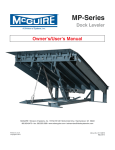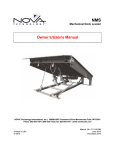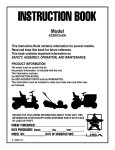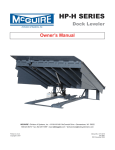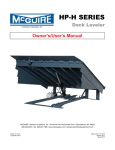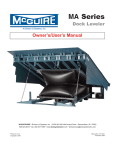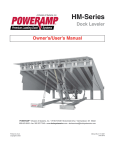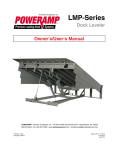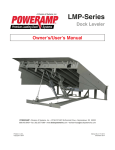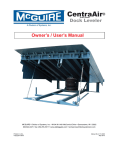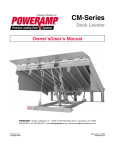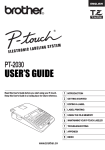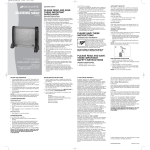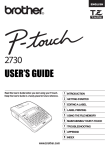Download “MP” SERIES Owner/User Manual
Transcript
MP-Series Dock Leveler Owner’s/User’s Manual MCGUIRE • Division of Systems, Inc. • W194 N11481 McCormick Drive • Germantown, WI 53022 800.624.8473 • fax: 262.255.9399 • www.wbmcguire.com • [email protected] Printed in U.S.A. Copyright © 2006 Manual No. 4111-0019 REV. April 2007 REV JULY 2007 REV November 2009 Table of Contents Page Safety Recognize Safety Information . . . . . . . . . . . . . . . . . . . . . . . . . . . . . . . General Operational Safety Precautions . . . . . . . . . . . . . . . . . . . . . . Operational Safety Precautions . . . . . . . . . . . . . . . . . . . . . . . . . . . . . Maintenance Safety Precautions . . . . . . . . . . . . . . . . . . . . . . . . . . . . Safety Decals . . . . . . . . . . . . . . . . . . . . . . . . . . . . . . . . . . . . . . . . . . . . 1 1 2 4 5 Introduction General Information . . . . . . . . . . . . . . . . . . . . . . . . . . . . . . . . . . . . . . . 7 Dock Leveler Stock Specifications . . . . . . . . . . . . . . . . . . . . . . . . . . . 7 Component Identification . . . . . . . . . . . . . . . . . . . . . . . . . . . . . . . . . . 8 Installation Prepare Pit . . . . . . . . . . . . . . . . . . . . . . . . . . . . . . . . . . . . . . . . . . . . . . 9 Prepare Dock Leveler . . . . . . . . . . . . . . . . . . . . . . . . . . . . . . . . . . . . .10 Install Dock Leveler . . . . . . . . . . . . . . . . . . . . . . . . . . . . . . . . . . . . . . 12 Operation Theory . . . . . . . . . . . . . . . . . . . . . . . . . . . . . . . . . . . . . . . . . . . . . . . . . Operating Instructions . . . . . . . . . . . . . . . . . . . . . . . . . . . . . . . . . . . . Ramp Loading/Unloading Instructions . . . . . . . . . . . . . . . . . . . . End Loading/Unloading Instructions . . . . . . . . . . . . . . . . . . . . . 17 18 19 20 Maintenance Service Dock Leveler Safely . . . . . . . . . . . . . . . . . . . . . . . . . . . . . . . 21 Periodic Maintenance . . . . . . . . . . . . . . . . . . . . . . . . . . . . . . . . . . . . . 22 Adjustments Adjust Lift Arm Spring and Lip Assist Spring Tension . . . . . . . . . . 24 Adjust Lip Stop Bolt . . . . . . . . . . . . . . . . . . . . . . . . . . . . . . . . . . . . . . 26 Troubleshooting Troubleshooting . . . . . . . . . . . . . . . . . . . . . . . . . . . . . . . . . . . . . . . . . 27 Parts Hold-Down Mechanism . . . . . . . . . . . . . . . . . . . . . . . . . . . . . . . . . . . Frame Components . . . . . . . . . . . . . . . . . . . . . . . . . . . . . . . . . . . . . . Platform Components . . . . . . . . . . . . . . . . . . . . . . . . . . . . . . . . . . . . Toe Guard/Weather Seal—Optional . . . . . . . . . . . . . . . . . . . . . . . . . . 29 30 32 36 Miscellaneous Customer Information . . . . . . . . . . . . . . . . . . . . . . . . . . . . . . . . . . . . 37 Warranty . . . . . . . . . . . . . . . . . . . . . . . . . . . . . . . . . . . . . . . . Back Cover 4111-0019 — Nov. 2006 REV April 2007 SAFETY Recognize Safety Information General Operational Safety Precautions Safety-Alert Symbol The Safety-Alert Symbol identifies important safety messages on equipment, safety signs, in manuals, or elsewhere. When you see this symbol, be alert to the possibility of personal injury or death. Follow the instructions in the safety message. Read and understand the operating instructions and become thoroughly familiar with the equipment and its controls before operating the dock leveler. Never operate a dock leveler while a safety device or guard is removed or disconnected. The use of the word DANGER signifies the presence of an extreme hazard or unsafe practice which will most likely result in severe injury or death. The use of the word WARNING signifies the presence of a serious hazard or unsafe practice which may result in serious injury or death. The use of the word CAUTION signifies possible hazard or unsafe practice which could result in personal injury. IMPORTANT The use of the word IMPORTANT is to draw attention to a procedure that needs to be followed to prevent machine damage. Never remove DANGER, WARNING, or CAUTION signs or decals on the equipment unless replacing them. e Op in g rat ne Zo g tin era p O Zo ne DO NOT activate the equipment until all unauthorized personnel in the area have been warned and have moved outside the operating zone. Remove any tools or foreign objects from the operating zone before starting. Keep the operating zone free of obstacles that could cause a person to trip or fall. 1 4111-0019 — Nov. 2009 SAFETY Operational Safety Precautions Learn the safe way to operate this equipment. Read and understand the manufacturer's instructions. If you have any questions, ask your supervisor. Stay clear of dock leveling device when freight carrier is entering or leaving area. Chock/restrain all freight carriers. Never remove the wheel chocks until loading or unloading is finished and truck driver has been given permission to drive away. Do not move or use the dock leveling device if anyone is under or in front of it. Do not use a broken or damaged dock leveling device. Make sure proper service and maintenance procedures have been performed before using. Keep hands and feet clear of pinch points. Avoid putting any part of your body near moving parts. Make sure lip overlaps onto trailer at least 4 in. (102 mm). Keep a safe distance from both side edges. 2 4111-0019 — Nov. 2006 REV. April 2007 SAFETY Do not use dock leveling device if freight carrier is too high or too low. Do not overload the dock leveling device. Do not operate any equipment while under the influence of alcohol or drugs. Do not leave equipment or material unattended on dock leveling device. 3 4111-0019 — Nov. 2009 SAFETY Maintenance Safety Precautions DO NOT grind or weld if hydraulic fluid or other flammable liquid is present on the surface to be ground or welded Always post safety warnings and barricade the work area at dock level and ground level to prevent unauthorized use of the unit before maintenance is complete. DO NOT grind or weld if uncontained hydraulic fluid or other flammable liquid is present. Stray sparks can ignite spills or leaks near the work area. Always clean up the oil leaks and spills before proceeding with grinding or welding. Always keep a fire extinguisher of the proper type nearby when grinding or welding. Failure to follow these instructions may result in serious personal injury or death. ALWAYS stand clear of dock leveler lip when working in front of the dock leveler. Failure to do this may result in serious personal injury or death. When engaging the maintenance prop ensure the bridge pin is set in place and closed before servicing or maintainning the unit. 4 4111-0019 — Nov. 2006 REV. April 2007 SAFETY Safety Decals Every 90 days (quarterly) inspect all safety labels and tags to ensure they are on the dock leveler and are easily legible. If any are missing or require replacement, please call 1-800-643-5424 for replacements. DANGER CRUSH HAZARD Maintenance prop must support leveler behind bar. Do not force maintenance prop forward of bar to support lip. Refer to owner’s/user’s manual for proper use. Failure to comply will result in death or serious injury. 1751-0727 1751-0727 1751-0730 (x2) DANGER SAFETY INFORMATION Unsupported dock leveler ramps can lower unexpectedly. Before allowing vehicle to leave the dock always: ! Ensure that no equipment, material or people are on the dock leveler. ! Return the dock leveler to its stored position at dock level. Failure to follow posted instructions will result in death or serious injury. Operation 1. Read and follow all instructions and warnings in the owner’s/user’s manual. 2. Use of dock leveler restricted to trained operators 3. Always chock trailer wheels or engage truck restraint before operating dock leveler or beginning to load or unload. 4. Never use hands or equipment to move the ramp or lip 5. Before activating dock leveler: ¥ Ensure trailer is backed in against bumpers. ¥ Remove any end loads if required. ¥ Check trailer alignment to avoid lip interference. If lip does not lower to trailer bed, reposition vehicle. 6. Ensure that truck bed supports extended lip or the leveler frame supports the ramp before driving on ramp. 7. Stay clear of hinges and front and sides of moving dock leveler. 8. Never use damaged or malfunctioning dock leveler. Report problems immediately to supervisor. Maintenance/Service 1. Read and follow all instructions, warnings and maintenance schedules in the owner’s/user’s manual. 2. Maintenance/Service of dock leveler restricted to trained personnel. 3. Place barriers on the driveway and on dock floor to indicate service work is being performed. 4. DO NOT ENTER PIT unless dock leveler is securely supported by maintenance prop. 5. If electrically powered turn off and use OSHA lockout/tagout procedures. Call 262.255.1510 for replacement placards, warning labels, or owner’s/user’s manuals. (decal placed in same position on both sides) 1751-0329 (x2) DO NOT FORK THIS SIDE (decal placed in same position on both sides) FORK HERE 1751-0330 (x2) (decal placed in same position on both sides) 1751-0728 DANGER CRUSH HAZARD Do not remove main springs until leveler is safely supported by maintenance prop. Main springs contain stored energy. Be sure springs are fully unloaded and ends are loose before removal. Refer to owner’s/user’s manual for proper maintenance procedure. Failure to comply will result in death or serious injury. 1751-0728 1751-0729 DANGER CRUSH HAZARD Do not work under dock leveler unless this maintenance prop has been secured in the upright position. See owner’s/user’s manual for proper procedures. Failure to comply 1751-0729 will result in death or serious injury. DANGER 1751-0731 CRUSH HAZARD Open the pin latch and insert through the maintenance prop housing and prop completely. Close the pin latch to secure prop. Use every time dock leveler is serviced. Failure to comply will result in death or serious injury. 1751-0731 DANGER 1751-0726 CRUSH HAZARD DO NOT ENTER PIT unless dock leveler is safely supported by maintenance prop. Place barriers on driveway and dock floor to indicate service work being performed. Refer to owner’s/user’s manual for proper maintenance procedures. Failure to comply will result in death or serious injury. 1751-0726 5 4111-0019 — Nov. 2009 SAFETY Every 90 days (quarterly) inspect all safety labels and tags to ensure they are on the dock leveler and are easily legible. If any are missing or require replacement, please call 1-800-643-5424 for replacements. DANGER CRUSH HAZARD Maintenance prop must support leveler behind bar. Do not force maintenance prop forward of bar to support lip. Refer to owner’s/user’s manual for proper use. Failure to comply will result in death or serious injury. 1751-0727 1751-0727 1751-0730 (x2) DANGER SAFETY INFORMATION Unsupported dock leveler ramps can lower unexpectedly. Before allowing vehicle to leave the dock always: ! Ensure that no equipment, material or people are on the dock leveler. ! Return the dock leveler to its stored position at dock level. Failure to follow posted instructions will result in death or serious injury. Operation 1. Read and follow all instructions and warnings in the owner’s/user’s manual. 2. Use of dock leveler restricted to trained operators 3. Always chock trailer wheels or engage truck restraint before operating dock leveler or beginning to load or unload. 4. Never use hands or equipment to move the ramp or lip 5. Before activating dock leveler: ¥ Ensure trailer is backed in against bumpers. ¥ Remove any end loads if required. ¥ Check trailer alignment to avoid lip interference. If lip does not lower to trailer bed, reposition vehicle. 6. Ensure that truck bed supports extended lip or the leveler frame supports the ramp before driving on ramp. 7. Stay clear of hinges and front and sides of moving dock leveler. 8. Never use damaged or malfunctioning dock leveler. Report problems immediately to supervisor. Maintenance/Service 1. Read and follow all instructions, warnings and maintenance schedules in the owner’s/user’s manual. 2. Maintenance/Service of dock leveler restricted to trained personnel. 3. Place barriers on the driveway and on dock floor to indicate service work is being performed. 4. DO NOT ENTER PIT unless dock leveler is securely supported by maintenance prop. 5. If electrically powered turn off and use OSHA lockout/tagout procedures. Call 262.255.1510 for replacement placards, warning labels, or owner’s/user’s manuals. (decal placed in same position on both sides) 1751-0329 (x2) DO NOT FORK THIS SIDE (decal placed in same position on both sides) FORK HERE 1751-0330 (x2) (decal placed in same position on both sides) 1751-0138 1751-0729 ! DANGER CRUSH HAZARD DO NOT REMOVE hydraulic cylinder until leveler is safely supported by maintenance prop. Refer to owner’s/user’s manual for proper maintenance procedure. Failure to comply will result in death or serious injury. DANGER CRUSH HAZARD Do not work under dock leveler unless this maintenance prop has been secured in the upright position. See owner’s/user’s manual for proper procedures. Failure to comply 1751-0729 will result in death or serious injury. DANGER 1751-0731 CRUSH HAZARD Open the pin latch and insert through the maintenance prop housing and prop completely. Close the pin latch to secure prop. Use every time dock leveler is serviced. Failure to comply will result in death or serious injury. 1751-0731 DANGER 1751-0726 CRUSH HAZARD DO NOT ENTER PIT unless dock leveler is safely supported by maintenance prop. Place barriers on driveway and dock floor to indicate service work being performed. Refer to owner’s/user’s manual for proper maintenance procedures. Failure to comply will result in death or serious injury. 1751-0726 INTRODUCTION General Information Dock Leveler Stock Specifications MP-Series dock levelers are available in the following sizes, weight capacities, and options: Width 6 ft (1828.8 mm) 6-1/2 ft (1981.2 mm) 7 ft (2133.6 mm) Length 6 ft (1828.8 mm) 8 ft (2438 mm) 10 ft (3048 mm) Congratulations on your choice of a McGuire dock leveler. This manual covers the MP-series mechanical dock leveler. Designed by McGuire to be a marvel of simplicity and efficiency, your dock leveler, when properly installed, will provide many years of trouble-free performance with an absolute minimum of maintenance. To obtain maximum performance and longest possible use, a simple program of preventive maintenance is recommended. Capacity (CIR*) 25,000 lb (11 340 kg) 30,000 lb (13 608 kg) 35,000 lb (15 876 kg) 40 000 lb (18 144 kg) 45 000 lb (20 412 kg) 55 000 lb (22 680 kg) * CIR (Comparative Industry Rating) Call McGuire for your specific needs. Once again, thank you and congratulations on your purchase of a McGuire mechanical dock leveler. 7 4111-0019 — Nov. 2009 INTRODUCTION Component Identification 1 2 3 4 5 — Lip — Lip Maintenance Prop — Platform — Lip Link — Lip Assist Spring 8 6 — Hold Down Release Ring 7 — Ratchet Pawl 8 — Ratchet Bar 9 — Hold Down 10 — Platform Maintenance Prop 11— Main Base Frame 12 — Safety Leg Assy. 13 — Lip (Snubber) Spring 14 — Lip Shock Absorber 15— Safety Leg Pull Chain 16 — Lift Arm Assembly 17 — Lift (Main) Spring 18 — Prop. Pin and Clip 19 — Working Range Toe Guards 4111-0019 — Nov -2006 REV. April 2007 INSTALLATION Prepare Pit A C B D A— Distance (Pit Width) (Front and Rear) B — Distance (Dock Floor-to-Pit Floor) (All Four Corners) C — Distance (Pit Length) (Both Sides of Pit) D — Distance (Pit Corner-to-Corner) (Top, Bottom, and Both Sides) Before lowering the dock leveler into the pit, the following must be performed: Post safety warnings and barricade the work area at dock level and ground level to prevent unauthorized use of the dock leveler before installation has been completed. Failure to follow the installation instructions can result in damage to dock leveler, the facilities, and/or serious personal injury or death. Only trained installation professionals with the proper equipment should install this product. IMPORTANT DO NOT remove the shipping bands around the dock leveler lip until instructed to do so. 1. Remove all debris from the pit and sweep the pit clean. 2. Check the entire dock leveler pit for proper construction according to approved/certified pit drawings. Make sure pit is square by making the following measurements: • Measure pit width distance (A) at both front and rear of pit. • Measure dock floor-to-pit floor distance (B) at all four corners. • Measure pit length distance (C) at both sides. • Measure corner-to-corner (criss-cross) distance (D) at both sides. Take measurements at dock floor level and at pit floor level. If any measurement is off by more than 1/8 in. (3.18 mm), contact McGuire Technical Services before proceeding. 9 4111-0019 — Nov. 2009 INSTALLATION Prepare Dock Leveler A B A— Lifting Bracket (2 used) The dock leveler is heavy. Use a lifting device and chains with the appropriate lifting capacity and reach. Always use the lifting brackets provided with the unit whenever lowering or lifting a dock leveler into or out of a pit. B — Shipping Bands McGuire dock levelers are designed with installation in mind. Each unit is shipped with lifting brackets (A) fastened to the platform side joists. IMPORTANT DO NOT remove the shipping bands (B) around the platform lip and leveler frame at this time. The shipping bands are needed to hold the leveler together during the installation process. Failure to follow these instructions may result in damage to the dock leveler and/or serious personal injury or death. NOTE: A third sling may be used to install the unit as needed. 10 4111-0019 — Nov. 2006 REV. April 2007 INSTALLATION 1. Remove any bumpers that may be banded, or bolted to the frame of the dock leveler. DO NOT remove the shipping bands (B) around the platform lip and leveler frame at this time. IMPORTANT DO NOT over-tighten the lifting bracket hardware. Over-tightening can damage the weather seal, if equipped. 4. Remove wood blocks that are attached to the leveler frame before putting the dock leveler into the pit. 5. To pick up the unit from the rear, slide forks into the fork slots and under the cross member. Shown below. 6. To pick up the unit from the front, move forks closer together and slide over the frame and under the cross member. It may be necessary to unband the unit to gain access to the front, by lifting the lip up then sliding the forks under the cross member. NOTE: Overall width of platform and lifting brackets (A) must be kept to a minimum to prevent interference between the lifting brackets and the pit walls as the dock leveler is lowered into the pit. 2. Make sure the mounting hardware of lifting brackets (A) is snug. The brackets should pivot relatively freely on the mounting cap screw. DO NOT over-tighten. 3. Attach lifting chains to lifting brackets (A) and to a lifting device (i.e., hoist or fork truck) having the appropriate lifting capacity and reach. REAR PICK UP FRONT PICK UP 11 4111-0019 — Nov. 2009 INSTALLATION Install Dock Leveler Shim Stacking Methods M N P Q A— Distance (Leveler Frame Height) B— Shim Locations (Under Rear Vertical Supports, 4-5 Places TYP) C— Shim Locations (Under Lip Keepers, Lifter Arm and Prop) D— Dock Floor E— Rear Pit Curb Angle 12 F— String G— Rear Hinge Frame Angle H— Distance (Dock Floor-toPit Floor) J— Distance (Top of Shim Stack-to-Dock Floor) K— Shim Stack L— Dock Leveler Frame M — Pyramid (Preferred) N— Stepped (Acceptable) P— Offset (Not Acceptable) Q — Straight (Not Acceptable) 4111-0019 — Nov. 2006 REV. April 2007 INSTALLATION NOTE: McGuire dock levelers are designed with a nominal 1/2 in. (12.7 mm) shimming distance to allow for pit inconsistencies. 1. Determine height of shim stack (K) for each shim location (B) by performing the following: a. Measure leveler frame height distance (A). b. Measure dock floor-to-pit floor distance (H) at each shim location (B). Write down the dimensions obtained at each location. c. Subtract distance (A) from distance (H) to obtain the shim height. Repeat for each shim location. IMPORTANT The minimum size of the shim that contacts the leveler frame (i.e., the top shim of each shim stack) must be at least 4-1/2 x 4-1/2 in. (114.3 x 114.3 mm) to support the full width of the frame rail and to provide a shelf for a fillet weld. Use the thickest shim stock possible for stability and weld penetration purposes. DO NOT use multiple layers of 1/8 in. (3.18 mm) or thinner shim stock. 2. Using the results obtained in step 1, create the individual shim stacks on the pit floor at locations (B). Build each shim stack (K) using the pyramid method (M) (preferred) or stepped method (N) with the top shim having a minimum size of 4-1/2 x 4-1/2 in. (114.3 x 114.3 mm) and each successive lower shim being larger so the shims can be welded together using a fillet weld. DO NOT use offset method (P) or straight method (Q). 4. Put a 1/4 in. (6.6 mm) thick shim at locations (C) (under lip keepers/maintenance prop and safety legs). Make sure shims are larger than frame front flat so pyramid or stepped stacking method can be used. NOTE: A 1/4 in. (6.6 mm) thick shim at locations (C) is used only as a starting point. The final shim stack height will be determined after the dock leveler is lowered into the pit. The dock leveler is heavy. Use chains and a lifting device with the appropriate lifting capacity and reach. Failure to do so may result in damage to dock leveler and/or serious personal injury or death. 5. Using an appropriate lifting device connected to the lifting brackets, lower dock leveler into the pit so rear hinge frame angle (G) is tight against rear pit curb angle (E) across full width of the leveler frame. 6. Allow rear of dock leveler to rest on the rear shims while keeping the front of the dock leveler level with the dock floor. 7. Add shims at front shim locations (C) so front of dock leveler will stay level with dock floor when leveler is resting fully on shims. NOTE: To assist in obtaining an accurate measurement of distance (J), use a string (F) pulled tight across the pit opening, directly over the shim locations. 3. Verify that each shim stack is at the correct height by measuring distance (J) [top of shim stack (K) to dock floor]. Distance (J) must equal the dock leveler height (A). 13 4111-0019 — Nov. 2009 INSTALLATION A— Front of Dock Pit B— Dock Leveler Frame C— Side Pit Curb Angle D— Gap [3/4 in. (19 mm) Minimum] 8. With rear hinge frame angle (F) tight against rear pit curb angle (G), perform/check the following: • Pry between the platform and rear hinge frame angle at locations (E) to make sure rear edge of platform is parallel to the rear hinge frame angle (F). • Gap (D) must exist equally along both sides of leveler so weather seal (if equipped) will not bind during dock leveler operation. 9. If gap (D) cannot be obtained equally at both sides of leveler, grind or add material at the rear edge of rear hinge frame angle (F) as needed. 14 E— Pry Locations G— Rear Pit Curb Angle F— Rear Hinge Frame Angle H— Flare Bevel Weld, Typical (To Fit Spacing) 10. Allow the dock leveler to rest fully on the shim stacks. Make sure the leveler is in the crosstraffic (stored) position with lip resting on lip keepers. 11. Check that a smooth and level transition exists between the dock floor and the dock leveler platform. Add or remove shims as necessary until a smooth transition is obtained. 12. If leveler cannot be squared and made level as instructed in steps 8 – 10, contact McGuire Technical Services. 4111-0019 — Nov. 2006 REV. April 2007 INSTALLATION DO NOT grind or weld if hydraulic fluid or other flammable liquid is present on the surface to be ground or welded. DO NOT grind or weld if uncontained hydraulic fluid or other flammable liquid is present. Stray sparks can ignite spills or leaks near the work area. Always clean up the oil leaks and spills before proceeding with grinding or welding. 14. Weld front of dock leveler frame (B) to shims located under the keepers, then weld the shims to the front pit curb steel. Make sure all personnel are outside of the leveler operating zone and stand clear of the platform lip before removing the shipping bands. Failure to do this may result in serious personal injury or death. Always keep a fire extinguisher of the proper type nearby when grinding or welding. 15. With the leveler welded in place remove the shipping bands from around the lip and frame. Failure to follow these instructions may result in serious personal injury or death. 16. Disconnect lifting device and chains from the lifting brackets. IMPORTANT Always ground welding equipment to the dock leveler frame, NEVER to the platform. DO NOT weld continuously along the full length of the rear hinge frame angle. This can put unnecessary stress on the leveler components, causing the leveler not to function correctly and shorten the lifespan of the affected components. NOTE: The illustration on the previous page shows a typical weld pattern. The weld pattern will vary slightly depending on size of dock leveler. 13. With the rear hinge frame angle (F) tight against the rear pit curb angle (G), weld the rear hinge frame angle (F) to the rear pit curb angle (G) using a 3/8 in. (9.5 mm) flare bevel skip weld — each weld being 6 in. (152 mm) long. Start at each end with a 6 in. (152 mm) long weld. Space all the other welds out evenly leaving approximately 6 in. (152 mm) space between each weld. Alternate welding locations to distribute heat. Welding sequentially from one end to the other may cause warping or distortion. Make sure all personnel are outside of the leveler operating zone and clear of the platform lip before activating the leveler. Failure to do this may result in serious personal injury or death. IMPORTANT When activating the leveler, always pull AND hold the platform release ring until the platform is at the full-raised position. Releasing the ring while the platform is still rising may result in damage to the equipment. 17. Pull and hold the release ring (located in recess at rear of platform) until the platform is fully raised. Check for binding as platform rises. 18. Slowly walk out onto the platform to lower the platform. Allow the platform to lower to the cross-traffic position. Check for binding as platform lowers. 19. If binding occurs, reposition leveler and/or add or remove shims as necessary. Raise and lower platform again. If platform still binds, contact McGuire Technical Services for further instructions. 20. Check that the leveler is flush with the dock floor and that the platform lip contacts both lip keepers evenly. 15 4111-0019 — Nov. 2009 INSTALLATION A— Platform Release Ring B— Platform Maintenance C —Lip prop support Prop Chain 21. Pull the release ring (A) to raise platform. Engage the platform maintenance prop (B) in the service (upright) position and lock the maintenance prop at this position using an OSHA approved locking device, supplied by others Engage lip maintenance prop(C). Make sure the platform is properly supported in the raised position before entering the pit to finish weld the shims. Failure to do this may result in serious personal injury or death. 22. Install shims under lift arm at locations using the pyramid shimming method. (Page 12)The lift arm pivot must be solidly shimmed the entire length of the lift arm pivot. Make sure the lift arm pivot is level from side-to-side. D — Prop Pin and Clip E —Safety Leg Pull 25. Remove the lifting brackets from the platform side joists. 26. Disengage the platform maintenance prop. 27. Slowly walk out onto the platform to lower the platform until it is at the cross-traffic (stored) position. 28. Check operation of dock leveler by cycling the leveler at least four times. • When the platform is at full height, lip will be fully extended. • Lip will begin to drop after the unit begins to lower to truck bed. 29. Check below-dock position by walking platform down before lip folds completely. • Lip will be over lip keepers. • Platform safety legs will be resting on frame. 23. Finish weld all shims using a fillet weld. • Weld all shims within each shim stack to each other, then weld the shim stack to the leveler frame. • Weld the front leveler frame shim stacks to the front pit curb steel if not done previously. 24. When all welding has been completed, remove all slag then paint all the welds and shims. 16 30. Check full below-dock position by walking the platform down. Pull and hold safety leg chain (E) before lip folds completely. 31. If the lip does not extend fully or lip folds too quickly, see appropriate symptom in the Troubleshooting section. 32. Install the dock bumpers as required, clean weld splatter and touch up with spray paint. 4111-0019 — Nov. 2006 REV. April 2007 OPERATION Theory 1 — Lip 2 — Lip Maintenance Prop 3 — Platform 4 — Lip Link 5 — Lip Assist Spring 6 — Hold Down Release Ring 7— Ratchet Pawl 8— Ratchet Bar 9 — Hold down The MP-series mechanical dock leveler uses large lift springs (18) to apply force to lift arm (17). The lift arm pushes against the underside of the platform (3), rolling on the cam (not pictured) forcing the platform to rise. The force of the spring tension is just enough to lift the weight of the platform and extend lip. IMPORTANT When activating the leveler, always pull AND hold the platform release ring until the platform is at the full raised position. Releasing the ring while the platform is still rising may result in damage to the equipment. To actuate the dock leveler platform, the operator pulls and holds the platform release ring (6) located in the recess at the rear of the platform. This causes ratchet pawl (7) to disengage from ratchet bar (8). With the ratchet pawl disengaged, spring tension from lift springs (18) forces the platform to rise. NOTE: Ratchet pawl (7) and bar (8) are part of the hold-down mechanism (9) 10 — Platform Maintenance Prop 11— Main Base Frame 12 — Safety Leg Assy. 13 — Snubber Spring 14 — Gas Shock 15 — Safety Leg Below Dock Control 16— Safety Leg Retract Pull Ring 17 — Lift Arm 18 — Lift Springs The ratchet pawl disengages only when the platform release ring (6) is pulled AND held. Spring tension from pawl spring causes the ratchet pawl to engage the ratchet bar when the release ring is let go. When the platform rises to approximately 2 – 3 inches (51 – 76 mm) from its full raised height, the lip snubber spring (13) and a chain pulls the lip link (4) down. This, in conjunction with the lip assist spring (5), causes the lip linkage to push the lip out and up. The lip assist spring also helps control the amount of time required for the lip to fully fold. To lower the platform, the operator walks out onto the platform. The platform will lower until the extended lip rests on the truck bed. If the lip did not fully extend or there is no truck at the dock, the platform will lower until one of the following conditions occur: • Lip is resting on lip keepers (cross-traffic position). • Lip did not fully fold causing the platform to rest on safety legs (below-dock position). • Lip did not fully fold and safety legs are retracted, causing the platform to rest on the safety stops (full below-dock position). The hold-down ratchet assembly will keep the platform at the desired position until the platform release ring is pulled again. 17 4111-0019 — Nov. 2009 OPERATION Operating Instructions Stay clear of dock leveler when freight carrier is entering or leaving dock area. 12 in. (305 mm) DO NOT raise or lower the dock leveler if anyone is under or in front of leveler. 12 in. (305 mm) Keep hands and feet clear of pinch points. Avoid putting any part of your body near moving parts. Failure to follow these instructions may result in severe personal injury or death. DO NOT activate the dock leveler until the truck/trailer is positioned squarely against the bumpers and the truck wheels are chocked. The MP-series mechanical dock leveler is designed to compensate for ± 12 in. (305 mm) of height difference between the loading dock and the truck bed. DO NOT use the dock leveler if the truck/trailer bed is more than 12 in. (305 mm) higher or lower than the dock floor. DO NOT overload the dock leveler. DO NOT operate any equipment while under the influence of alcohol or drugs. Never remove the wheel chocks until loading and unloading is finished and truck driver has been given permission to leave. DO NOT leave equipment or material unattended on the dock leveler. DO NOT use the dock leveler if the freight carrier is too high or too low. Failure to follow these instructions may result in personal injury and/or damage to equipment. NEVER use a fork truck or any other material handling equipment to lower the dock leveler. DO NOT drive any equipment onto the dock leveler until platform lip is resting on the truck/trailer with at least 4 in. (102 mm) of overlap. Always maintain a safe distance from side edges of leveler during the loading and unloading process. IMPORTANT When activating the leveler, always pull AND hold the platform release ring until the platform is at the full-raised position. Releasing the ring while the platform is still rising may result in damage to the equipment. NEVER attempt to walk on an unsupported lip. NEVER allow untrained personnel to operate the dock leveler. The dock leveler operation instructions are divided into the two methods of loading and unloading: NEVER attempt to lift any part of the leveler by hand. • For ramp loading and unloading, see Ramp Loading/Unloading Instructions on page 19. Failure to follow these instructions may result in serious personal injury or death. • For end loading and unloading, see End Loading/Unloading Instructions on page 20. 18 4111-0019 — Nov. 2006 REV. April 2007 OPERATION Operating Instructions — Continued Ramp Loading/Unloading Instructions NOTE: If end unloading is required, see End Loading/Unloading Instructions on page 20. 1. Check to make sure truck/trailer is positioned squarely against dock bumpers. 7. Make sure that the lip is fully extended and supported on the truck/trailer along the entire width of the platform with at least 4 in. (102 mm) of lip contacting the truck bed. 2. Instruct driver to remain at the dock until the loading or unloading process has been completed. 3. Chock the truck/trailer wheels or use truck restraint if present. 8. Proceed with loading or unloading. A NOTE: If end loading is necessary, see End Loading/Unloading Instructions on page 20. A 4. Raise the platform by pulling and holding the platform release ring (A). 5. Hold the release ring until the platform is at the fully-raised position and lip is fully extended. B 9. When the loading or unloading process has been completed, return platform to cross-traffic (stored) position as follows: a. Raise the platform to the full-raised position by pulling and holding the platform release ring (A). 6. Walk out onto the platform. The platform will lower until the lip rests on the truck/trailer bed. NOTE: If the truck/trailer bed is below dock level, pull and hold the safety leg retract pull ring (B) (located in a recess at front of the platform) until the platform lip is resting on the truck/trailer bed. b. Lower platform by slowly walking out onto the platform allowing time for the lip to fully fold and clear the truck/trailer. Continue walking out on platform until platform lowers to the cross-traffic position (lip engages in the lip keepers). 10. Remove chocks from truck/trailer wheels or release truck restraint if used. 11. Indicate to driver that truck may leave the dock. 19 4111-0019 — Nov. 2009 OPERATION Operating Instructions — Continued End Loading/Unloading Instructions NOTE: End loading or unloading can be done with the dock at the cross-traffic position or below-dock position depending on the height of the truck/trailer bed. B 1. Check to make sure truck/trailer is positioned squarely against dock bumpers. 2. Instruct driver to remain at the dock until the loading or unloading process has been completed, and instructed to leave. 3. Chock the truck/trailer wheels or use truck restraint if present. 6. Slowly walk the platform down allowing enough time for the lip to fold. Just before the platform reaches the cross-traffic position, pull and hold the safety leg retract pull ring (B) (located in a recess at front of the platform). The platform will continue lowering to the full below dock position. End Loading/Unloading — Platform at Cross-Traffic Position. End Loading/Unloading — Platform at Below-Dock Position. 4. If truck/trailer bed is at or above dock floor level, leave leveler at the cross-traffic position and proceed with loading or unloading. When finished, perform steps 9 and 10. 7. Proceed with loading or unloading. If truck/trailer bed is below the dock floor level, perform steps 5 – 10. A NOTE: When end unloading is finished and additional access to the truck/trailer requires that the platform lip be extended, see Ramp Loading/Unloading Instructions on page 19 for further instructions. 8. When loading or unloading is finished, raise the platform to the full-raised position by pulling and holding the platform release ring. Slowly walk the platform down, allowing enough time for the lip to fold. The platform will lower to the cross-traffic position (lip engages in the lip keepers). 9. Remove chocks from truck/trailer wheels or release truck restraint if used. 5. Pull and hold the platform release ring (A) until the platform is at the fully-raised position. 20 10. Indicate to the driver that the truck may leave the dock. 4111-0019 — Nov. 2006 REV. April 2007 MAINTENANCE Service Dock Leveler Safely A— Platform Release Ring B — Platform Maintenance Prop C— Lip Maintenance Prop D— Prop Pin and Clip E— Safety Leg Pull Chain Always post safety warnings and barricade the work area at dock level and ground level to prevent unauthorized use of the dock leveler before maintenance is complete. Failure to do this may result in serious personal injury or death. Always stand clear of the dock leveler lip when working in front of the dock leveler. Failure to do this may result in serious personal injury or death. The platform maintenance prop MUST be in the service position when working under the dock leveler. For maximum protection, use an OSHA approved lock out tag out device.supplied by others, to lock the maintenance prop in the service position. Only the person servicing the equipment should have the key to unlock the maintenance prop. Whenever maintenance is to be performed under the dock leveler platform, support the platform with the platform maintenance prop (B). Put the platform maintenance prop in the service (upright) position so that the prop is cradled in back of the header plate and the underside of the deck plate. Secure the platform maintenance prop in this position by inserting the pin or attaching an OSHA approved lockout device* and tagout device*, supplied by others . Only the person servicing the equipment should have the capability to remove the lockout device. The tagout device must inform that repairs are in process and clearly state who is responsible for the lockout condition. If maintenance requires that the lip be in the extended position, raise the lip by hand and support the lip with the lip maintenance prop (C). NOTE: Make sure to disengage the lip maintenance prop and allow the lip to fold fully before disengaging the platform maintenance prop. Failure to follow these instructions may result in serious personal injury or death. * Refer to OSHA regulation 1910.147. 21 4111-0019 — Nov. 2009 MAINTENANCE Periodic Maintenance 1 — Lip Hinge Grease Fittings 2 — Lip Maintenance Prop Pivot 3 — Lift Arm Roller Bushing 4 — Lift Arm Pivot 5 — Hold-Down Pivot/Pulley 6— Safety Leg Linkage Pivots Always post safety warnings and barricade the work area at dock level and ground level to prevent unauthorized use of the dock leveler before maintenance is complete. Failure to do this may result in serious personal injury or death. Always stand clear of the dock leveler lip when working in front of the dock leveler. Failure to do this may result in serious personal injury or death. 22 7 — Lip Lift Assist Pin 8 — Hold Down-to-Platform Pin The platform maintenance prop MUST be in the service position when working under the dock leveler. For maximum protection, use an OSHA approved locking device to lock the maintenance prop in the service position, supplied by others. Only the person servicing the equipment should have the key to unlock the maintenance prop. Failure to follow these instructions may result in serious personal injury or death. 4111-0019 — Nov. 2006 REV. April 2007 MAINTENANCE Regular maintenance must be performed on a weekly and quarterly schedule. Weekly Maintenance Quarterly Maintenance • Operate the dock leveler through the complete operating cycle to maintain lubrication. • Lubricate the following areas with light-weight machine oil: NOTE: To thoroughly inspect the platform hinge area, position the platform in the full below-dock position. (2)— Lip maintenance prop pivot • Inspect the platform hinge and the lip hinge areas. The hinge areas must be kept free of dirt and debris. Build-up of foreign material in the hinge areas will increase wear and cause abnormal operation. (6)— Safety leg linkage pivots (5)— Hold-down pivot/pulley (8)— Hold down-to-platform pin • Lubricate the following areas with white lithium grease: IMPORTANT Failure to properly lubricate the dock leveler will cause abnormal operation of the leveler. (1)— Lip hinge area (inject grease into all the lip hinge grease fittings) (3)—Lift arm roller bushing DO NOT lubricate the hold-down ratchet bar and pawl. (4)— Lift arm pivot (7)— Lip assist pin 23 4111-0019 — Nov. 2009 ADJUSTMENTS Adjust Lift Arm Spring and Lip Assist Spring Tension 1 — Jam Nut 2 — AdjustableNut 3 — Lip Assist Spring 4— Lift Springs Always post safety warnings and barricade the work area at dock level and ground level to prevent unauthorized use of the dock leveler before maintenance is complete. Failure to do this may result in serious personal injury or death. Always stand clear of the dock leveler lip when working in front of the dock leveler. Failure to do this may result in serious personal injury or death. 24 5 — Lift Spring Bolt 6 — Hold-Down Mechanism The platform maintenance prop MUST be in the service position when working under the dock leveler. For maximum protection, use an OSHA approved locking device to lock the maintenance prop in the service position supplied by others. Only the person servicing the equipment should have the key to unlock the maintenance prop. Failure to follow these instructions may result in serious personal injury or death. 4111-0019 — Nov. 2006 REV. April 2007 ADJUSTMENTS NOTE: Adjusting the tension of lift springs (4) usually requires that the lip assist spring (3) also be adjusted. If the platform does not rise fully and/or lip does not extend fully, the lift spring tension may be set too low. If the platform cannot be walked down or is difficult to walk down, the lift spring tension may be set too high. 3. After lift spring adjustment is completed, check operation of the lip. • If the lip folds before the platform can be walked down, tension of lip assist spring (3) may be set too low. • If the lip does not fold fully or takes too long to fold, tension of lip assist spring (3) may be set too high. 4. Adjust lip assist spring tension as follows: If the platform does not rise fully on its own, it may be necessary to use an external lifting device. Use a lifting device with the appropriate lifting capacity to safely raise the platform. Make sure to engage and pin the platform maintenance prop after raising the platform. Failure to do this may result in serious personal injury or death. IMPORTANT When using an external lifting device to raise the platform, make sure hold-down mechanism (6) is disengaged. Pull and hold platform release ring during the lifting process to avoid shearing the ratchet pawl and ratchet bar teeth. 1. Raise the platform and engage the platform maintenance prop. Pin the maintenance prop in the service position using attached pin device. NOTE: Use two-turn increments when adjusting lip assist spring (3). Check lip operation after each adjustment. Repeat until proper operation is obtained. a. Loosen jam nut (1). b. To increase spring compression, turn nut (2) clockwise. c. To decrease spring compression, turn nut (2) counterclockwise. d. Tighten jam nut. 5. Recheck operation of platform and lip. Readjust lift spring tension and lip assist spring tension until proper operation is obtained. 2. Adjust tension of lift springs (4) as follows: NOTE: Use 1/2 turn increments when adjusting lift spring bolt (5).Turn clockwise to increase tension and counterclockwise to decrease tension. Check platform operation after each adjustment. Repeat until proper operation is obtained. • To increase lift spring tension, turn lift spring bolt (5) clockwise. • To decrease lift spring tension, turn lift spring bolt (5) counterclockwise. 25 4111-0019 — Nov. 2009 ADJUSTMENTS Adjust Lip Stop Bolt Always post safety warnings and barricade the work area at dock level and ground level to prevent unauthorized use of the dock leveler before maintenance is complete. Failure to do this may result in serious personal injury or death. A B Always stand clear of the dock leveler lip when working in front of the dock leveler. Failure to do this may result in serious personal injury or death. C E D The platform maintenance prop MUST be in the service position when working under the dock leveler. For maximum protection, use an OSHA approved locking device, supplied by others, to lock the maintenance prop in the service position. Only the person servicing the equipment should have the key to unlock the maintenance prop. Failure to follow these instructions may result in serious personal injury or death. Check that lip (E) is fully resting on the lip keepers (D) and at the lowest part of the lip keepers. If lip is not resting properly in lip keepers, perform the following adjustment. 1. Fully raise platform. Manually raise the lip and engage lip maintenance prop. 2. Loosen jam nut (B). A— Platform B— Jam Nut C— Stop Bolt D — Lip Keeper E — Lip 4. Tighten jam nut. 5. Disengage lip maintenance prop. 6. Walk platform down to cross-traffic (stored) position. 7. Check lip position in both keepers. Repeat procedure if necessary. 3. Adjust stop bolt (C) as necessary. • Turn stop bolt “in” (clockwise) to allow lip to fold closer to platform (A). • Turn stop bolt “out” (counterclockwise) to hold lip further away from platform (A). 26 4111-0019 — Nov. 2006 REV. April 2007 TROUBLESHOOTING Troubleshooting Always post safety warnings and barricade the work area at dock level and ground level to prevent unauthorized use of the dock leveler before maintenance is complete. Failure to do this may result in serious personal injury or death. Always stand clear of the dock leveler lip when working in front of the dock leveler. Failure to do this may result in serious personal injury or death. Symptom Platform does not rise. Possible Cause The platform maintenance prop MUST be in the service position when working under the dock leveler. For maximum protection, use an OSHA approved locking device to lock the maintenance prop in the service position, supplied by others. Only the person servicing the equipment should have the key to unlock the maintenance prop. Failure to follow these instructions may result in serious personal injury or death. Solution Heavy object(s) on platform. Remove object(s) from platform. NOTE: For safety reasons, the dock leveler is designed to lift only the platform’s own weight. Disconnected or broken release chain. Connect or replace chain. Dock leveler binds. Check for visible obstructions that could cause binding. Check weather seal if equipped. If no obstructions found, call McGuire Technical Services. See inside back cover for phone number and address. Platform rises slowly or does not rise to the full raised position. Heavy object(s) on platform. Remove object(s) from platform. NOTE: For safety reasons, the dock leveler is designed to lift only the platform’s own weight. Dock leveler binds. Check for visible obstructions that could cause binding. Check weather seal if equipped. If no obstructions found, call McGuire Technical Services. See inside back cover for phone number and address. Insufficient main spring tension. Increase tension on main springs. (See Adjust Lift Arm Spring and Lip Assist Spring Tension in the Adjustments section.) Damaged or worn hold-down mechanism. Clean and inspect hold-down mechanism. 27 4111-0019 — Nov. 2009 TROUBLESHOOTING Symptom Platform rises to full height, but lip does not fully extend. Possible Cause Lip assist chain disconnected or broken. Connect or replace chain. Insufficient main spring tension. Increase tension on main lift springs. (See Adjust Lift Arm Spring and Lip Assist Spring Tension in the Adjustments section.) Insufficient lip assist force. Increase lip assist spring compression. (See Adjust Lift Arm Spring and Lip Assist Spring Compression in the Adjustments section.) Platform does not lower Excessive main spring when operator walks out tension. onto the platform. Lip folds too fast during normal walk-down. Platform does not stay down. Lip does not fold after truck departs. 28 Solution Reduce main spring tension. (See Adjust Lift Arm Spring and Lip Assist Spring Tension in the Adjustments section.) Damaged or worn hold-down mechanism. Clean and inspect hold-down mechanism. Insufficient lip assist force. Increase lip assist spring compression. (See Adjust Lift Arm Spring and Lip Assist Spring compression in the Adjustments section.) Disconnected, worn, or broken gas strut. Inspect shock absorber. Connect or replace gas strut. Entangled release chain. Remove cause of entanglement. Dirt impacted in ratchet bar teeth. Clean and inspect ratchet bar and ratchet pawl teeth. DO NOT lubricate the ratchet assembly. Broken or damaged ratchet assembly teeth. Replace ratchet assembly. DO NOT lubricate the ratchet assembly. Disconnected or broken hold-down pivot pins. Replace hold-down pivot pins. Damaged or worn hold-down mechanism. Clean and inspect hold-down mechanism. Lip hinge binding because of lack of lubrication Inject grease into all of the lip hinge grease fittings. (See Periodic Maintenance in the Maintenance section.) Excessive lip assist force. Decrease lip assist spring compression. (See Adjust Lift Arm Spring and Lip Assist Spring Compression in the Adjustments section.) 4111-0019 — Nov. 2006 PARTS Hold-Down PAWL AND RATCHET Item Quantity Part Number A 1 M512-986 Description Ratchet and Pawl Assembly Set 29 4111-0019 — Nov. 2009 PARTS Frame Components 30 4111-0019 — Nov. 2006 REV. April 2007 PARTS Frame Components BASE FRAMES ITEM QTY 1 6 FOOT 6.0 FOOT 25K/55K 8 FOOT 6.0 FOOT 25K/55K 10 FOOT 6.0 FOOT 25K/55K 1 16 8435-5000 16 8435-5003 16 8435-5006 1 18 8435-5001 18 8435-5004 18 8435-5007 1 20 8435-5002 20 8435-5005 20 8435-5008 6.5 FOOT 6.5 FOOT 6.5 FOOT 1 16 8435-5009 16 8435-5012 16 8435-5015 1 18 8435-5010 18 8435-5013 18 8435-5016 1 20 8435-5011 20 8435-5014 20 8435-5017 7.0 FOOT 7.0 FOOT 7.0 FOOT 1 16 8435-5018 16 8435-5021 16 8435-5024 1 18 8435-5019 18 8435-5022 18 8435-5025 1 20 8435-5020 20 8435-5023 20 8435-5026 SAME SAME DOTP-6424 LIFTER ARM 25 IN (6WD 25K) DOTP-6416 LIFTER ARM DOTP-6423 LIFTER ARM 27 IN( all others) 9224-0031 MAINT PROP 2 1 M502-089 HOLD DOWN 3 1 DOTP-6423 LIFTER ARM 27 IN. 4 1 9224-0030 MAINT PROP 5 1 9221-0028 MAINT PROP PIVOT SAME SAME 6 1 DOTH-2555 SPRING, SNUBBER SAME SAME 7 3 OTH-2356 PIN, CLEVIS SAME SAME 8 1 OTH-2405 ROLLER, HOLD DOWN SAME SAME 9 1 DOTH-2416 LAP LINK SAME SAME 10 1 DFRA-0323 PLATE SPRING 11 9224-0079 MAINT PROP DFRA-0322 PLATE SPRING DOTH-6875 PLATE SPRING DPLA-1218 T BAR ASSY DOTH-6425 BOLT SPRING ADJ 12 2 OTH-2218 WASHERS SAME 13 1 DOTH-2185 NUT COUPLING NONE 14 2 OTH-2222 WASHERS SAME SAME 15 4 OTH-2374 PIN, COTTER SAME SAME 16 1 DFRA-1205 PIN LIFTER ARM SAME SAME 17 1 DFRA-0328 CHAIN 6 FOOT 18 2 8432-1129 2 8432-1130 DFRA-0329 SAME CHAIN, 8 FOOT DFRA-0340 CHAIN, 10 FOOT KEEPER LIP 16 SAME 8432-1132 24 INCH PIT KEEPER LIP 18 SAME 8432-1133 24 INCH PIT 8432-1134 24 INCH PIT 2 8432-1131 KEEPER LIP 20 SAME 19 1 9201-0006 PROP PIN AND CLIP SAME SAME 20 21 1 1 DOTH-2401 DPLA-2128 CASTER WHEEL ASSY. CHAIN SNUBBER. SAME SAME SAME SAME Must provide dock leveler serial number, platform size, lip size, capacity, any options and pit depth when calling or faxing orders. 31 4111-0019 — Nov. 2009 PARTS Platform Components PLATFORMS ITEM QTY 1 32 6 FOOT 6.0 FOOT 6.5 FOOT 7.0 FOOT 8 FOOT 6.0 FOOT 6.5 FOOT 10 FOOT 7.0 FOOT 6.0 FOOT 6.5 FOOT 7.0 FOOT 1 25K 9515-5000 9515-5004 9515-5008 25K 9515-5012 9515-5016 9515-5020 25K 9515-5024 9515-5028 9515-5032 1 30K 9515-5001 9515-5005 9515-5009 30K 9515-5013 9515-5017 9515-5021 30K 9515-5025 9515-5029 9515-5033 1 35K 9515-5002 9515-5006 9515-5010 35K 9515-5014 9515-5018 9515-5022 35K 9515-5026 9515-5030 9515-5034 1 40K 9515-5003 9515-5007 9515-5011 40K 9515-5015 9515-5019 9515-5023 40K 9515-5027 9515-5031 9515-5035 1 45K 9515-5036 9515-5038 9515-5040 45K 9515-5042 9515-5044 9515-5046 45K 9515-5048 9515-5050 9515-5052 1 55K 9515-5037 9515-5039 9515-5041 55K 9515-5043 9515-5045 9515-5047 55K 9515-5049 9515-5051 9515-5053 4111-0019 — Nov. 2006 PARTS Platform Components 2 1 DPLA-0338 LIP BANGER ASSY. 3 2 DPLA-0340 BAR 9 1 DPLA-0343 BELOW DOCK CONTROL ASSY. 10 2 DOTH-2382 PIN, COTTER 11 1 DOTH-2074 BOLT, HEX 5/8-11 X 2.00 12 1 DOTH-2160 NUT, HEX 5/8-11 17 1 DPLA-0360 BDC PUSH ROD ASSY 18 1 DOTH-2060 BOLT SHOULDER 19 1 DOTH-2131 LOCK NUT 20 1 DOTH-6406 LIP ASSIST ROD 23 1 DOTH-2550 SPRING ,LIP ASSIST STD 25K- 55K 6’ 6.5’ WD 16” 24 1 DOTH-2546 SPRING ,LIP ASSIST HEAVY 7’WD 18”-20” 25K-- 7’WD 18”-20:” 30K -55K 25 1 DOTP-2006 LIP PROP BAR 26 1 DOTH-2062 SHOULDER BOLT 27 1 OTH-2131 LOCK NUT 28 2 OTH-2214 WASHER 29 1 DOTH-2547 SPRING COMPRESSION 30 1 DOTH-2582 SHOCK GAS 31 1 DOTH-2351 BOLT CLEVIS 32 1 DOTH-2374 PIN COTTER 33 2 DOTH-2210 WASHER, FLAT 34 1 DOTH-2163 LOCK NUT 35 LIP SHAFTS 2 6.0 FOOT DPLA-2101 2 6.5 FOOT DPLA-2102 2 7.0 FOOT DPLA-2103 36 2 DOTH-2355 PIN , CLEVIS 37 2 DOTH-2373 PIN, COTTER 39 2 2101-0079 WASHER, FLAT LIPS 38 6.0 FOOT 25K 30K 35K 40/45K 55K 1 16 0595-5000 0595-5009 0595-5018 0595-5027 0595-5036 1 18 0595-5001 0595-5010 0595-5019 0595-5028 0595-5037 20 0595-5002 0595-5011 0595-5020 0595-5029 0595-5038 1 16 0595-5003 0595-5012 0595-5021 0595-5030 0595-5039 1 18 0595-5004 0595-5013 0595-5022 0595-5031 0595-5040 1 20 0595-5005 0595-5014 0595-5023 0595-5032 0595-5041 1 16 0595-5006 0595-5015 0595-5024 0595-5033 0595-5042 1 18 0595-5007 0595-5016 0595-5025 0595-5034 0595-5043 1 20 0595-5008 0595-5017 0595-5026 0595-5035 0595-5044 1 6.5 FOOT 7.0 FOOT 1 Must provide dock leveler serial number, platform size, capacity, any options and lip size when calling or faxing orders. 33 4111-0019 — Nov. 2009 PARTS Platform Components 55 SEE CHART DOTH-2570 SPRING MAIN 6620 56 SEE CHART DOTH-2574 SPRING MAIN 6635 57 SEE CHART DOTH-2576 SPRING MAIN 6820 58 SEE CHART DOTH-2578 SPRING MAIN 6835 6 FOOT LONG 6.0 FOOT 25K 30K 35K 40K 45K 55K 16 (2)55, (1)56 (2)55, (1)56 (2)55, (1)56 (1)55, (2)56 (1)55, (2)56 (1)55, (2)56 18 (2)55, (1)56 (2)55, (1)56 (2)55, (1)56 (1)55, (2)56 (1)55, (2)56 (1)55, (2)56 20 (2)55, (1)56 (2)55, (1)56 (2)55, (1)56 (1)55, (2)56 (1)55, (2)56 (1)55, (2)56 16 (2)55, (1)56 (2)55, (1)56 (2)55, (1)56 (1)55, (2)56 (1)55, (2)56 (1)55, (2)56 18 (2)55, (1)56 (2)55, (1)56 (2)55, (1)56 (1)55, (2)56 (1)55, (2)56 (1)55, (2)56 20 (2)55, (1)56 (2)55, (1)56 (2)55, (1)56 (1)55, (2)56 (1)55, (2)56 (1)55, (2)56 16 (1)55, (2)56 (1)55, (2)56 (1)55, (2)56 (2)55, (2)56 (2)55, (2)56 (2)55, (2)56 18 (1)55, (2)56 (1)55, (2)56 (1)55, (2)56 (2)55, (2)56 (2)55, (2)56 (2)55, (2)56 20 (1)55, (2)56 (1)55, (2)56 (1)55, (2)56 (2)55, (2)56 (2)55, (2)56 (2)55, (2)56 6.5 FOOT 7.0 FOOT 8 FOOT LONG 6.0 FOOT 25K 30K 35K 40K 45K 55K 16 (4) 55 (4) 57 (4) 57 (4) 57 (4) 57 (4) 57 18 (4) 55 (4) 57 (4) 57 (4) 57 (4) 57 (4) 57 20 (2)55, (1)56 (4) 57 (4) 57 (4) 57 (2)57, (2)58 (2)57, (2)58 16 (4) 57 (4) 57 (4) 57 (4) 57 (2)57, (2)58 (2)57, (2)58 18 (4) 57 (4) 57 (4) 57 (2)57, (2)58 (2)57, (2)58 (2)57, (2)58 20 (4) 57 (4) 57 (4) 57 (2)57, (2)58 (2)57, (2)58 (2)57, (2)58 16 (4) 57 (4) 57 (4) 57 (4) 57 (2)57, (2)58 (4)58 18 (4) 57 (4) 57 (4) 57 (4) 57 (2)57, (2)58 (4)58 20 (4) 57 (4) 57 (4) 57 (4) 57 (2)57, (2)58 (4)58 6.5 FOOT 7.0 FOOT 10 FOOT LONG 6.0 FOOT 25K 30K 35K 40K 45K 55K 16 (8) 57 (8) 58 (8) 58 (8) 58 (8) 58 (8) 58 18 (8) 57 (8) 58 (8) 58 (8) 58 (8) 58 (8) 58 20 (8) 57 (8) 58 (8) 58 (8) 58 (8) 58 (8) 58 16 (8) 58 (8) 58 (8) 58 (8) 58 (8) 58 (8) 58 18 (8) 58 (8) 58 (8) 58 (8) 58 (8) 58 (8) 58 20 (8) 58 (8) 58 (8) 58 (8) 58 (8) 58 (8) 58 16 (8) 58 (8) 58 (8) 58 (8) 58 (8) 58 (8) 58 18 (8) 58 (8) 58 (8) 58 (8) 58 (8) 58 (8) 58 20 (8) 58 (8) 58 (8) 58 (8) 58 (8) 58 (8) 58 6.5 FOOT 7.0 FOOT 34 4111-0019 — Nov. 2006 REV. April 2007 PARTS Toe Guard/Weather Seal—Optional 10 12 11 9 5 3 6 1 6 2 7 4 8 FOOT 6 FOOT * 1 1 0014-0062 TOE GUARD LH MIDDLE 0014-0070 TOE GUARD LH MIDDLE 0014-0078 TOE GUARD LH MIDDLE 2 1 0014-0066 TOE GUARD LH LOWER 0014-0074 TOE GUARD LH LOWER 0014-0082 TOE GUARD LH LOWER 3 1 0014-0064 TOE GUARD RH MIDDLE 0014-0072 TOE GUARD RH MIDDLE 0014-0080 TOE GUARD RH MIDDLE 4 1 0014-0068 TOE GUARD RH LOWER 0014-0076 TOE GUARD RH LOWER 0014-0084 TOE GUARD RH LOWER 5 2 OTH-2043 SCREW CAP SAME SAME 6 4 OTH-2207 WASHER SAME SAME 7 2 OTH-2131 LOCK NUT * 1 DKIT-9179 FRTG COMPLETE R&L SAME 9 2 DOTH-2841 CHANNEL WEATHER SEAL 10 2 DOTH-2824 T-RUBBER WEATHER SEAL DOTH-2824 T-RUBBER WEATHER SEAL CONSULT FACTORY 11 2 DOTH-2822 BRUSH WEATHER SEAL DOTH-2822 BRUSH WEATHER SEAL CONSULT FACTORY 12 2 DOTH-2821 EXTRUSION ALUM. DOTH-2820 EXTRUSION ALUM. CONSULT FACTORY DKIT-9180 FRTG COMPLETE R&L DOTH-2840 CHANNEL WEATHER SEAL SAME DKIT-9181 FRTG COMPLETE R&L DOTH-2843 CHANNEL WEATHER SEAL 35 4111-0019 — Nov. 2009 This page intentionally left blank 36 4111-0019 — Nov. 2006 REV. April 2007 MISCELLANEOUS Customer Information A NOTE: Refer to illustration for left/right orientation of dock leveler. The model/serial number decal (A) is located on the right platform joist near the front (lip) of dock leveler. When you receive your MP-series dock leveler, write down the dock leveler model and serial number in the form provided. This will help ensure safe keeping of the numbers in the event the model/serial number decal (A) becomes lost or damaged. Also, write down McGuire’s job number, the company that installed the dock leveler, and the original owner’s name. This will all help to identify the specific dock leveler if more information is required. When ordering, use part numbers and description to help identify the item ordered. Do not use “item” numbers. These are only for locating the position of the parts. Always give dock leveler MODEL NUMBER and/or SERIAL NUMBER. For service, call or contact: Dock Leveler Information Model ___________________________________ Serial No._________________________________ McGiure’s Job No. ______________________ Original Owner Information Name ___________________________________ Address _________________________________ _________________________________ Installer Information Name ___________________________________ Address _________________________________ _________________________________ Date of Installation _________________________ Systems, Inc. P.O. Box 309 Germantown, WI 53022 Phone: (800) 624-8473 Fax: (262) 255-9399 37 4111-0019 — Nov. 2009 W.B.McGuire WARRANTY MP-SERIES MECHANICAL LEVELER McGuire, guarantees the materials, components, and workmanship in your McGuire MP-Series dock leveler to be of the highest quality and to be free of defects in material and workmanship for a full One (1) Year Base Warranty on all components. The Base Warranty includes replacement parts, labor, and freight. Structural components carry an additional four (4) year pro-rated warranty based on the application. Specifically, the structural warranty includes the frame, deck section, lip section, rear hinge, and front hinge. Systems, Inc., warrants all components to be free of defects in material and workmanship, under normal use, during the warranty period. This base warranty period begins upon the completion of the installation or the Sixtieth (60th) day after shipment, whichever is earlier. All guarantee claims will be settled on a timely basis when defects are found to be from other than improper installation, operating contrary to instructions or beyond rated load capacities, abuse, careless or negligent use, or failure to maintain the unit as recommended by the owner’s manual. There are no guarantees, either expressed or implied, including any implied guarantees of merchantability or fitness for a particular purpose which shall extend beyond the guarantee periods indicated above. This guarantee is valid only if the unit(s) is unaltered from original condition as delivered from the factory and a survey is completed by a McGuire representative.








































